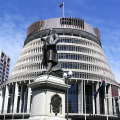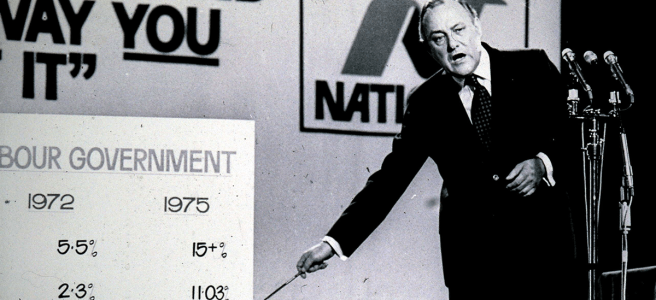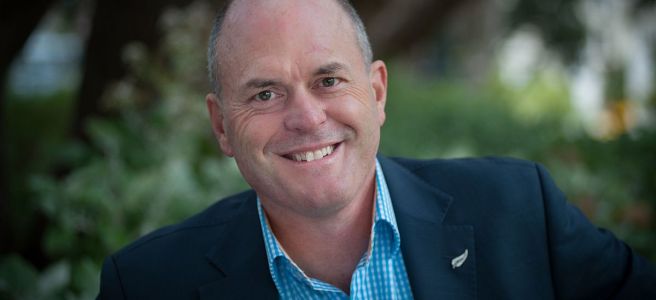Judith Collins may have led the New Zealand National Party to a catastrophic defeat in 2020. But the election result was not of her making. The real turning point for National came twelve weeks before Collins’ elevation to the leadership. In those days the Opposition could still boast of having more MPs than the Labour Party.
It was a Monday afternoon, the country was beginning a fifth week in Level 4 lockdown (all five million of us). The Prime Minister had just announced that full lockdown restrictions would remain in place for another five days before a gradual easing could begin. “No one wants to lose the huge gains we’ve made as a country off the back of the hard work of every New Zealander.”
But the announcement was disappointing for many. Those separated from their loved ones would have to wait longer. Uncertainty was also taking a huge emotional toll on small business owners who feared bankruptcy. Redundancies were mounting. Seven-thousand would queue for the dole that week alone.
Anguish turned to anger. Eliminating the virus could not possibly be worth the social and economic ruin of a draconian lockdown. They were suffocating in the oppressive atmosphere of their bubbles. Jacinda Ardern’s 1pm sermon from the ‘podium of truth’ was more jarring each day. Not everyone wanted to be on the Team of Five Million.
That afternoon the dissenters had a voice in Simon J. Bridges. The Leader of the Opposition stood before television cameras on the black and white tiles of Parliament House. He was a lonely figure on the Parliamentary precinct, with his staff and caucus working remotely. Bridges had earlier been criticised for not staying home in Tauranga.
He argued it was his constitutional duty to be there – even during a pandemic. More to the point, Bridges’ presence meant he could speak directly to the same journalists who breathlessly reported every utterance of the Prime Minister and officials. The rolling media coverage of the past month had been heavily slanted to the Government. Bridges offered a counter-narrative as Chair of the Epidemic Response Committee.
Half an hour ago he had published a 342-word statement on Facebook. “The decision for New Zealand to stay locked down in Level 4 shows the Government hasn’t done the groundwork required to have us ready,” the first line read. Yes, the lockdown had been effective, and New Zealanders could be proud of the sacrifices they had made. But surveillance testing had been too slow, and contact tracing was still inadequate.
Our lockdown was more restrictive than anywhere else and yet the outcome was not significantly different to that of Australia. The key difference was that Scott Morrison’s Australia had gone into lockdown with an exit strategy, choosing to pursue suppression rather than elimination. It remained to be seen which country would do better in the long-run. But for all its pride at going ‘hard and early’, the Ardern Government was still on the backfoot.
“I’m sure many Kiwis feel frustration that we still can’t do many things Australians have done,” Bridges went on. They had allowed more businesses to stay open through lockdown without case numbers soaring. He was now worried that the harm of staying in Level 4 would be greater than if we were to come out. It wasn’t just about the economic cost. Bridges was speaking of the social harm too.
“We will no doubt see a rise in mental health problems and stress related illnesses,” he wrote further. “I also have real concerns about the delay in healthcare for some people, like cancer treatment, screening and thousands of operations across the country.” At least 30,000 New Zealanders were desperately waiting for elective surgeries.
To his detractors on social media, Bridges was cynically manipulating a public health crisis for political advantage. And yet it was Bridges at his most empathetic. He worried for the people seeing their livelihoods disappear and their mental health deteriorate. It was about the butcher lying awake at night, or the person anxiously waiting to find out if they might have cancer.
“My worry is that a further week is a case of the medicine potentially being worse than the cure,” he declared.
While amateur linguists on Twitter debated the meaning of that malapropism, thousands reacted with anger on Facebook. Bridges was accused of “acting like a child” and potentially endangering lives. Long-time National voters publicly renounced their support, others called for a leadership change, and MPs began doing the numbers. Soon opinion polling would confirm a precipitous decline in the National vote.
The anti-lockdown statement triggered a response that the Leader of the Opposition was not equipped for. Bridges’ own approval ratings were already in the negative. The more likeable, easy-going persona he has cultivated since losing the leadership was not on display back then. Ironically, it was an emotional resonance with the victims of lockdown that proved fatal.
Bridges’ conservative disposition made him more pessimistic about the future, and sensitive to the threat of economic collapse. Perhaps he believed that a silent majority of New Zealanders felt his apprehension. They did not. Within a few days TVNZ released a Colmar Brunton poll showing that 87 percent approved of the government’s Covid-19 response.
As left-wing commentator Martyn ‘Bomber’ Bradbury opined at the time: “There is tone deaf and then there is Simon Bridges.” Our success in eliminating the virus had become a major source of national pride. The collective experience gave us a greater sense of community and optimism. Jacinda Ardern had restored faith in New Zealand exceptionalism: we once again led the world.
In the end, New Zealand got to have it both ways. Covid-19 was eliminated without social and economic ruin. Gross Domestic Product grew by 14 percent during the September quarter, more than enough to reverse the historic decline recorded in June. By mid-2021 unemployment was approaching pre-pandemic levels and it looked as though we might finally put coronavirus behind us. Despite a slow vaccine rollout the government was preparing to end our isolation with a ‘reconnection strategy’. The border would soon be open again.
That was the state of the nation on Tuesday, 17 August 2021. Four-hundred-and-eighty-five days after Bridges went public with his doubts about the elimination strategy, New Zealanders were feeling déjà vu. The Prime Minister once again declared that the whole country would go into a Level 4 lockdown. This time the notice was ‘short and sharp’. The highly infectious Delta variant, we were told, had “changed the game”.
In a curious quirk of history, the announcement coincided with the publication of Bridges’ memoir, National Identity. “This isn’t the book you write if you want to be leader,” he told journalist Andrea Vance. Few believed him. Having won over critics with a baby yak and self-deprecating humour on social media, he now revealed his more enlightened side. Rumour had it that he was plotting a comeback with the support of former Air New Zealand CEO Chris Luxon.
Timing is everything in politics, and the timing has suited Bridges. It has not suited Judith Collins. Her decision to remain leader after the humiliation of election night is a testament to Collin’s character. While a lot has been made of her ‘abrasive’ personality and negative campaigning, the real harm to National was done by those who conspired to undermine their vulnerable leader in the first lockdown.
Todd Muller’s supporters naively thought that replacing a parochial conservative with a more urbane one would restore National as the natural party of government. At first the plan appeared to work. Media became more favourable, the polling improved. Muller stumbled a few times but was able to regain his footing. Then something peculiar happened. He too fell down the Covid rabbit hole.
Muller’s first mistake was to state his disbelief that New Zealand was Covid-free. When the Ministry of Health announced that 51 returnees had recently left managed isolation facilities without being tested in June 2020, the new Leader of the Opposition went on Breakfast to comment: “I suspect what we’re going to find is it is out more in our community than what we have been told.”
A week earlier, officials had reported zero active cases. It was a milestone that Ardern celebrated with a “a little dance”. We, a small island nation in the Pacific, had done something the great powers of Europe and America could not do. New Zealanders were special in the eyes of the world. Muller’s scepticism caused an uncomfortable tension in the national psyche otherwise known as cognitive dissonance.
The Ministry of Health would concede months later that our Covid-free status in June of 2020 was ‘probably’ a myth. But like all great myths it had taken on a life of its own. Elimination was now an article of faith in our civic religion and anyone questioning it would be punished with derision. It wasn’t apparent at the time but Muller’s utterance on Breakfast that June morning was an act of self-destruction from which he never recovered. The bizarre leaking of Covid patient details by backbencher Hamish Walker and former party president Michelle Boag was to be the final act in the Muller tragedy.
The mantle of leadership passed to Collins. Her burning ambition to defeat Ardern and “take back the country” energised the National base. There was a fervor that had been lacking under Bridges, despite good polling. For a brief, flickering moment in time the election appeared competitive and National supporters dared to believe. But the comfortable middle-class in suburbia who once adored John Key were enamoured with Ardern.
A study undertaken by Australian market research firm McCrindle surveyed 1,000 New Zealanders between 29 July and 4 August 2020. The results give us a fascinating insight into the psychology of the electorate during Collins’ first weeks as leader. On average, New Zealanders were just as likely to be anxious as they were hopeful. But trust in the Prime Minister was rock solid with 72 percent reporting that she had inspired their confidence.
However, most ominously for Collins, was the proportion of New Zealanders over the age of 55 who reported feeling good. Only a third of babyboomers were anxious. Most were hopeful or resigned to the situation. Interestingly, 43 percent of those aged over 74 said they felt relaxed. While the published data excluded income and other socioeconomic variables it is a reasonable assumption that the older, more affluent voter who turned out for National in 2017 was happy.
Fire and brimstone wasn’t going to work in Ardern’s New Zealand. The tidal wave of discontent that Collins planned to ride never came. If the August 2020 outbreak had spread from Auckland to the rest of New Zealand, if the inadequacies of testing and contact tracing were fully exposed, and if the economic recovery never happened, then it is possible we would now be living under a Collins Government. She more than Bridges or Muller was the one to channel our anger.
No, the times have not suited Collins. Her argument with Breakfast host Indira Stewart and more recent comments about microbiologist Siouxsie Wiles (“big fat hypocrite”) have been lapped up by critics as proof that she is unfit to lead. New Zealanders, they argue, are measuring Collins against the standards of kindness and empathy set by Ardern. The Leader of the Opposition must at the very least be composed.
There are many within the National Party who think the solution is to turn back the clock. To return to that moment in April 2020 when Bridges lost his composure. If the rumours in Wellington are to be believed, then a leadership change is imminent. But doing to Collins what they did to Bridges will not resolve their dilemma. That is, how to oppose Labour without undermining the elimination myth?
The Ghost of Lockdowns Past will haunt National until it is exorcised.
This opinion piece was first published by Victoria University’s The Democracy Project and is republished with permission.


